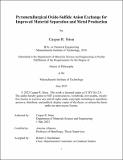Pyrometallurgical Oxide-Sulfide Anion Exchange for Improved Material Separation and Metal Production
Author(s)
Stinn, Caspar R.
DownloadThesis PDF (21.11Mb)
Advisor
Allanore, Antoine
Terms of use
Metadata
Show full item recordAbstract
Efforts to decarbonize, reduce water consumption, and respond to increasing feedstock complexity motivate the search for new processing pathways in mining, recycling, and metal production. Currently, environmentally tedious and economically burdensome chemical separations are required to produce pure compounds amenable to materials manufacturing and metal production. An alternative approach is the development of chemical pretreatments that enable low cost, environmentally sustainable physical separations instead. This can be accomplished via pyrometallurgical anion exchange chemistry. Revisiting separation pathways provides an added benefit; new separation chemistries can enable improved downstream processes for metal production without direct greenhouse gas emissions. Sulfur-based routes are expected to be particularly versatile. However, kinetic and thermodynamic unknowns currently hinder the deployment of sulfur-based separation chemistries.
Herein, thermodynamic modelling and oxide sulfidation kinetic measurements enable for the first time the establishment of an integrated thermodynamic, kinetic, and mass transport framework for pyrometallurgical oxide-sulfide anion exchange. Selective sulfidation via this methodology is established to be a low cost, sustainable pretreatment that enables high performance, environmentally friendly physical separations in place of legacy chemical approaches. This approach is shown to be effective across a range of modern materials processing challenges, including rare earth separation, lithium ion battery recycling, metal slag recycling, and commodity mineral processing. Separation metrics achieved through pyrometallurgical selective sulfidation exhibit order of magnitude improvements over state of the art hydrometallurgical pathways. Life cycle and technoeconomic assessments reveal these benefits also come at a fraction of the cost and environmental impact.
Furthermore, novel sulfide products from pyrometallurgical oxide-sulfide anion exchange are found to be amenable to metal production via simple vacuum thermal treatments. Aluminothermic reduction via reactive vacuum distillation is shown to enable manufacturing of a range of alloys from sulfide feedstocks without direct greenhouse gas emissions, including aluminum-manganese, aluminum scandium, ferronickel, ferrochromium, and iron-rare earth alloys. Together, sulfide-based processing pathways are found to unlock new synergies in metal separation and reduction for a sustainable materials future.
Date issued
2023-06Department
Massachusetts Institute of Technology. Department of Materials Science and EngineeringPublisher
Massachusetts Institute of Technology